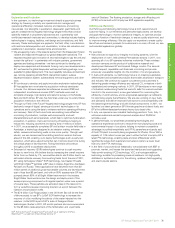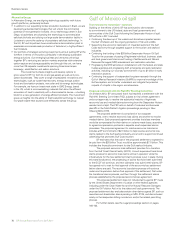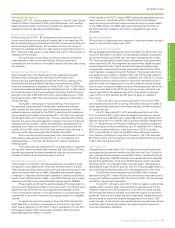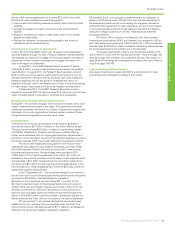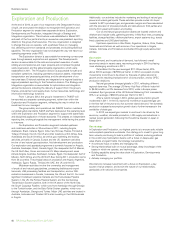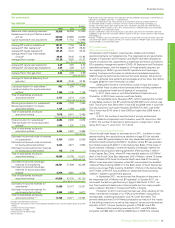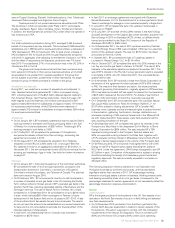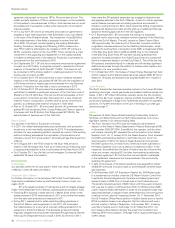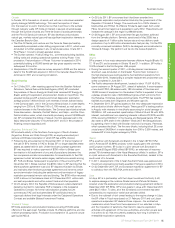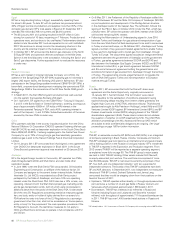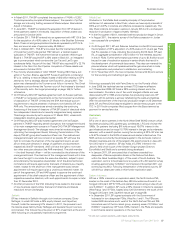BP 2011 Annual Report Download - page 79
Download and view the complete annual report
Please find page 79 of the 2011 BP annual report below. You can navigate through the pages in the report by either clicking on the pages listed below, or by using the keyword search tool below to find specific information within the annual report.
Business review: BP in more depth
BP Annual Report and Form 20-F 2011 77
Business review
Completing the response
Throughout 2011, BP, working under the direction of the US Coast Guard’s
Federal On-Scene Coordinator (FOSC), and collaboratively with individual
federal and state entities, continued to complete the Deepwater Horizon
operational response activities as described below.
Source control and site remediation
During the first half of 2011, BP completed the decommissioning of all
source control equipment including all vessels used in the response. We
also completed plugging and abandonment (P&A) of the second relief well
and conducted a seabed survey. BP conducted a further site survey of
the Macondo wellhead and the two relief wells during the third quarter of
2011. Following these surveys it was determined that no further activity is
necessary at the well site.
During the year we continued our efforts to recover and recycle
waste material in order to minimize impacts. We also continued or
completed the site remediation of multiple locations that were used during
the response.
Residual clean-up in the Gulf of Mexico
Since the beginning of the Deepwater Horizon response multi-party
Shoreline Clean-up Assessment Technique (SCAT) teams have
continuously and systematically surveyed the shoreline to assess oiling
conditions and develop shoreline treatment recommendations (STRs),
which are implemented at the direction of the FOSC. Over 110,000 miles
of aerial reconnaissance flights were conducted across the 11,000 miles of
Gulf Coast shoreline. From this surveillance information, the SCAT teams
identified more than 4,300 miles for further, ground-based survey. Of the
Gulf Coast shoreline, 635 miles required some measure of mechanical or
manual cleaning.
During 2011, mechanical or manual cleaning of the majority of
the segments was completed. Patrolling and maintenance activities
were initiated and will continue until the shoreline segments meet the
applicable clean-up standards for the FOSC to determine that operational
removal activity is complete. In November 2011, the FOSC also approved
the Shoreline Clean-up Completion plan. This plan describes the process
whereby the various shoreline segments included in the area of response
operations can be surveyed, verified as meeting the applicable clean-up
standards, and moved out of operational activity. It is expected that the
majority of the 4,300 miles of the Gulf Coast shoreline within the area of
response will be deemed operationally complete within 2012.
Environmentally sensitive areas were often hand cleaned. In some
areas cleaning was paused at the direction of, or in consultation with,
wildlife scientists, to minimize interference with migration patterns or
breeding cycles.
The Coast Guard has indicated that if oil is discovered in a segment
that has been deemed operationally complete, the Coast Guard will follow
long-standing response protocols established under the law and contact
whoever it believes is the responsible party or parties.
Response efforts guided by science
At the direction of the FOSC, scientific studies were conducted to study
the status of oil and dispersants in the water and sediments of the Gulf.
These studies are being used to guide continuing response activities in the
near shore environment and to better understand the potential impacts
of residual oil. These results have been published in Operational Scientific
Advisory Team (OSAT) reports (OSAT-1 and OSAT-2 reports, and a toxicity
addendum) and Net Environmental Benefits Analysis reports (NEBAs).
These reports confirmed the appropriateness of the steps taken to
remove oil and mitigate the impact on the environment. The OSAT-2 report
determined that further efforts, beyond guidelines established by the
FOSC to remove the residual oil from the shoreline, could potentially pose
a greater risk to the environment than allowing the residual oil to degrade
naturally.
To assess the potential impacts on fauna, the FOSC directed the
OSAT scientists to conduct a comprehensive toxicity study. The report,
which was an addendum to the OSAT-1 report, was issued on 8 July 2011.
Of the approximately 3,500 toxicity tests conducted, 90% showed no
statistically significant effects on wildlife.
At the request of the FOSC, several NEBA studies and specialized activities
were carried out, including an effort to detect anchors that had been
deployed during the response to keep containment boom in place. Based
on the NEBA results, the NEBA team recommended that the FOSC let
the anchors remain in place to allow them to degrade through natural
processes.
Economic restoration
BP continued to support economic recovery in local communities through a
variety of actions and programmes in 2011.
Deepwater Horizon Trust activity
BP has established the Deepwater Horizon Oil Spill Trust (the Trust) in the
amount of $20 billion to be used in compensating individuals, businesses,
government entities and others who have been impacted by the oil spill.
The Trust provides funds to satisfy legitimate state and local government
claims resolved by BP, final judgments and settlements, legitimate state
and local response costs, natural resource damages and related costs,
and legitimate individual and business claims administered by the GCCF,
which has been managed by Kenneth Feinberg. The proposed economic
loss settlement announced on 3 March 2012 with the Plaintiffs’ Steering
Committee on MDL 2179 provides for a transition from the GCCF. A court-
supervised transitional claims process for economic loss claims will be in
operation while the infrastructure for the new settlement claims process
is put in place. During this transitional period, the processing of claims that
have been submitted to the GCCF will continue and new claimants may
submit their claims. The establishment of the Trust does not represent
a cap or floor on BP’s liabilities and BP does not admit to a liability of
this amount.
In 2011, $1 billion was voluntarily set aside in the Trust for NRD
early restoration projects. BP is working with federal and state trustees to
select appropriate projects that will enhance habitats, wildlife and access
for recreational use.
As at 31 December 2011, BP’s cumulative contributions to the
Trust amounted to $15.1 billion since its inception, including our second-
year commitment of $5 billion and a total of $5.1 billion cash settlements
received during 2011 from MOEX USA Corporation (MOEX), Weatherford
US., L.P. (Weatherford), and Anadarko Petroleum Corporation (Anadarko).
The remaining committed contributions as at 31 December 2011 totalling
$4.9 billion are scheduled to be made by the end of 2012. In January
2012, we contributed to the Trust the $250 million settlement received
from Cameron International Corporation (Cameron). The Trust disbursed
$3.7 billion in 2011 and the total paid out since its establishment amounted
to $6.7 billion by the end of 2011.
Claims payments
All payments that were made in 2011 for legitimate claims by individuals,
businesses and government entities were paid from the Trust. During the
year, individuals and businesses received $3.1 billion in payments through
the GCCF. More than 189,000 individual and business claimants accepted
full and final settlements, while about 33,000 received interim payments.
Since May 2010, more than $6.2 billion has been paid to individuals and
businesses through the claims process, with the Trust paying $5.8 billion of
this and BP paying the remainder prior to the establishment of the Trust.
Government entities received more than $40 million in claims
payments during 2011. Nearly 60 loss-of-revenue claims have been paid to
government entities since May 2010. By the end of 2011, BP had resolved
over 90% of government claims filed.
During 2011, BP paid a total of $7.7 million to vessel owners whose
vessels were involved in clean-up and protection activities as part of the
Vessels of Opportunity (VoO) programme. In an effort to ensure fairness,
BP instructed the external adjusters to broaden the original compensation
guidelines. Once the new guidelines were established, adjusters have and
are continuing to re-examine property damage claims from about 1,200
vessel owners, whose property-damage claims had previously been denied
or partially paid to ensure that property damages reported by claimants
have been adequately addressed.










